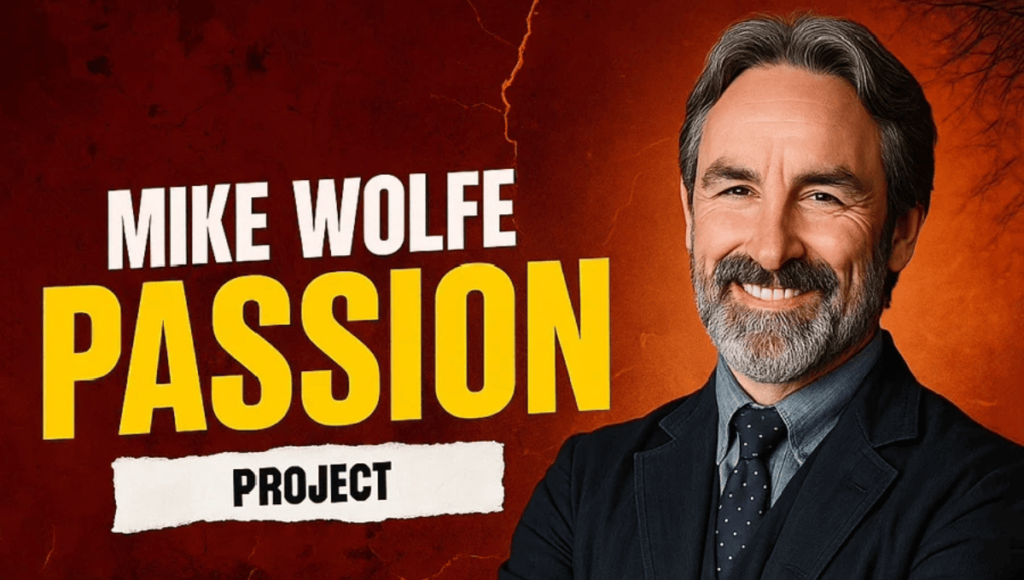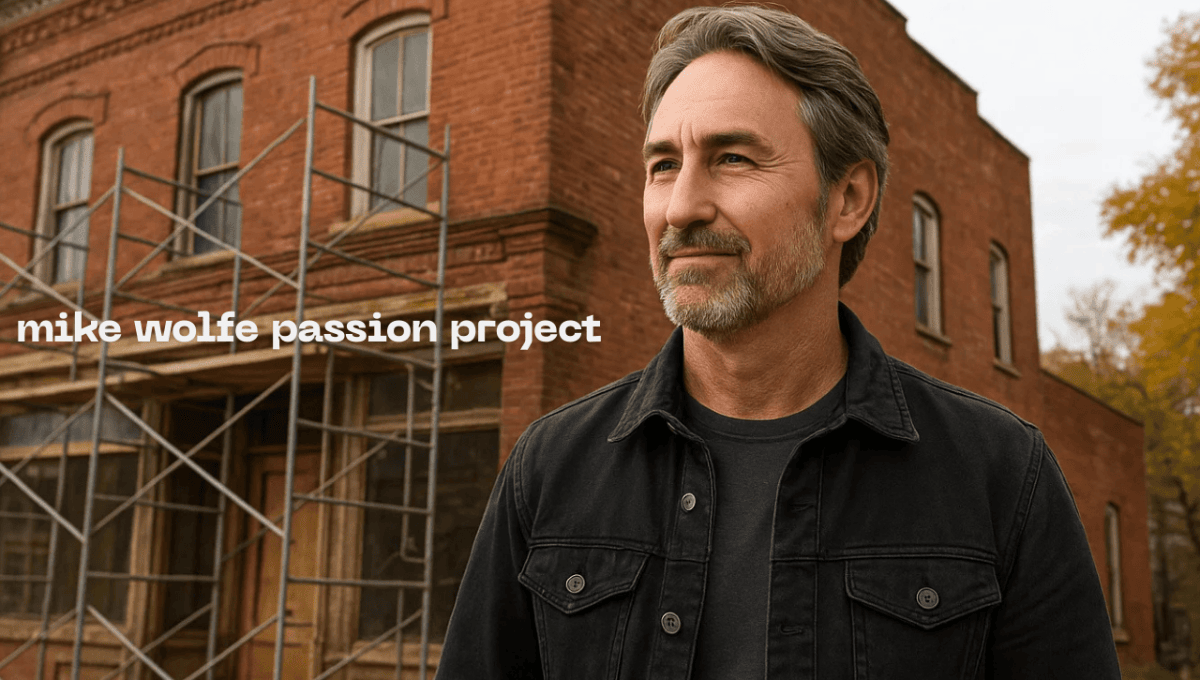- From Picker to Preservationist: The Roots of the Passion Project
- What Exactly Is the Mike Wolfe Passion Project?
- Turning Gas Stations Into Gathering Spots: Real Examples
- Challenges, Risks, and Fan Concerns in the Mix
- Why It Matters: Impact Beyond One Man’s Vision?
- What Lies Ahead for the Passion Project?
Most folks know Mike Wolfe from American Pickers, hunting for cool old stuff in barns. But what a lot of people miss is that his real passion isn’t just a side thing – it’s his way of bringing history back to life, helping communities, and telling stories through everything he finds.
In this article, we’ll journey into the world behind the cameras and follow how the Mike Wolfe passion project emerged, what it encompasses today, and why it matters to fans, small towns, and history lovers alike.
From Picker to Preservationist: The Roots of the Passion Project
Mike Wolfe’s story didn’t start with TV deals or cameras. Wolfe’s childhood in Joliet, Illinois, sparked a love for old stuff – bikes, tools, signs. He saw stories in what others trashed. This grew into a passion for saving objects and their histories. American Pickers made him famous, giving him a stage and the means to do even more.

But Wolfe eventually realized that while discovering antiques is thrilling, the bigger treasure lies in the places those antiques came from — buildings, small towns, hidden corners of American life. That realization catalyzed the shift from mere picking to preservation.
What Exactly Is the Mike Wolfe Passion Project?
The Mike Wolfe passion project is not confined to a single method or medium. It’s a multi-dimensional mission with overlapping elements of architecture, community revitalization, storytelling, design, and artisan support. At its core, Wolfe bowls for rescuing places and artifacts before they vanish, and giving them renewed purpose.
One visible strand of this project is historic building restoration. Wolfe buys old, run-down buildings in places like Columbia, Tennessee, and LeClaire, Iowa, and fixes them up while keeping their original vibe. He changes them into places for the community, art studios, event spots, or cool little shops to keep them going.
Another thread is storytelling and design. Wolfe documents each restoration’s journey, shares the narratives behind objects and buildings, and uses design to connect past and present – preserving patina, signage, craftsmanship rather than erasing it. The passion project also includes Wolfe’s digital presence via Two Lanes, a platform where vintage Americana, travel, craftspeople, and community stories converge. Two Lanes shows off creators, cool American backroad pics, and hand-picked items that match his love for keeping things alive.
Wolfe’s work is about helping communities. He wants to bring back neighborhoods, back local artists, and make people proud of their towns again. Often, local schools, volunteers, and people get involved in fixing things up.
And yes, Wolfe is also hands-on with his own home renovations. His Columbia, Tennessee residence and related real estate have been ongoing labor and symbols of the deeper commitment behind the passion project.
Turning Gas Stations Into Gathering Spots: Real Examples
Ideas are inspiring, but Wolfe’s passion project is defined by tangible transformations. One standout example is his restoration of a historic Esso gas station in Columbia, Tennessee. Wolfe bought the building and brought it back to life as a spot for people to hang out. He posted updates, saying it would be a place called Revival, with food, drinks, outdoor seats, and a local vibe. Proud to credit collaborators, he expressed that the once-ignored corner now has a renewed role in the town’s life.
In LeClaire, Iowa — Wolfe’s base for Antique Archaeology — he’s invested in revitalizing downtown and preserving the architectural charm that made the town special in the first place. He purchased and restored older storefronts, integrates historic doors and features into his own projects, and sees the entire town as an evolving canvas in the passion project.
These are not just vanity restorations. They are strategic, purposeful, and intentional statements: history matters, and local identity deserves care.
Challenges, Risks, and Fan Concerns in the Mix
Big projects like this always have problems. Fixing up old buildings means dealing with rules, zones, permits, and surprise fixes, which can cost more than you think. Finding the right old-style materials, saving what’s original, and making the old and new work together is tricky.
Because Wolfe’s public persona is tied to adventure and bold discovery, fans sometimes express concern about risky methods. In 2025, for instance, Wolfe shared photos of himself working on a Two Lanes Guesthouse in Iowa. In one shot, a bicycle hung over a staircase while he balanced on a ladder above. Fans chimed in, commenting about ladder safety and asking whether the setup looked “OSHA approved.” This illustrated that in executing his passion, Wolfe also battles optics around safety and finish quality.
Another dimension: Wolfe asked fans to help locate parts for a 1930s Indian motorcycle he’s been restoring for years. He reached out publicly via Instagram, saying he needed wheels. That blending between a public persona, fan community, and the nuts-and-bolts of restoration is part of the charm, but also opens him up to scrutiny, expectation, and pressure.
Lastly, time and money are constraints. Wolfe reportedly spent over $200,000 renovating a historic Tennessee home he purchased, dealing with permit complexities and structural issues.
Despite these challenges, Wolfe persists — not for profit, but for purpose.
Why It Matters: Impact Beyond One Man’s Vision?
You might ask: why does the Mike Wolfe passion project deserve attention beyond its aesthetic appeal or fan fascination? The answer lies in how it bridges past and future, people and places.
First, it redefines preservation as living, not static. By putting restored buildings back into use — as retail spaces, gathering venues, shops — Wolfe ensures they remain relevant. History becomes part of daily life, not a museum artifact.
Also, fixing old buildings helps the town’s money situation, which can bring tourists and spruce up shops. Dying towns get a makeover, giving residents a better sense of home.
Also, Wolfe’s work makes craftsmanship better. When he fixes up old buildings, he hires talented people who are good at working with wood, metal, bricks, old building parts, signs, and designs. That helps ensure these trades survive and get respected.
Fourth, narrative matters. Through storytelling and documentation, Wolfe gives voice to places that rarely make headlines. Objects and buildings carry human memory; by preserving them, he preserves identity.
Last, inspiration is contagious. The passion project invites others to see value in their own history: that old barn, that cracked window frame, that peeling sign might hold stories worth saving. With Wolfe’s high profile, the message reaches more people, fans may feel motivated to contribute locally or simply to look at their surroundings with fresh eyes.
What Lies Ahead for the Passion Project?
While many buildings are already restored, Wolfe has ambitious goals. The “100 Buildings, 100 Stories” idea has been floated, aiming to restore one significant structure in each U.S. state by 2027. That would turn the passion project into a nationwide tapestry of preserved memory.
Expansion is also expected through Two Lanes, more original content, greater artisan partnerships, and curated goods linking preservation with commerce.
Wolfe’s really focusing on boosting LeClaire, his hometown. He’s fixing up Main Street storefronts to draw in more visitors and make the town a go-to spot for fans and history buffs.

Plus, we may see short documentaries or media features that give deeper visibility to hidden projects that don’t necessarily scream “TV show.” Because for Wolfe, the passion project is not about ratings, it’s about legacy.
Final Reflections on Mike Wolfe Passion Project
When you peel back the layers of American Pickers, you find more than rusty treasures. You find a man driven by reverence for America’s material stories and a willingness to act. Mike Wolfe’s work proves he’s more than a collector and TV personality; he’s serious about saving our culture. It’s a reminder that history hides in plain sight. We can save these memories if we try. Old stories can be revived and passed on to the next generation.
So yes, when fans search “Mike Wolfe passion project,” they’re following more than a restoration. They are witnessing a movement: one that says the past is not dead, the forgotten deserves a second chance, and the stories we rescue today become the heritage we pass on tomorrow.
Mike Wolfe passion project is more than a hobby. It’s a mission, a calling, and perhaps one of his most enduring legacies.



